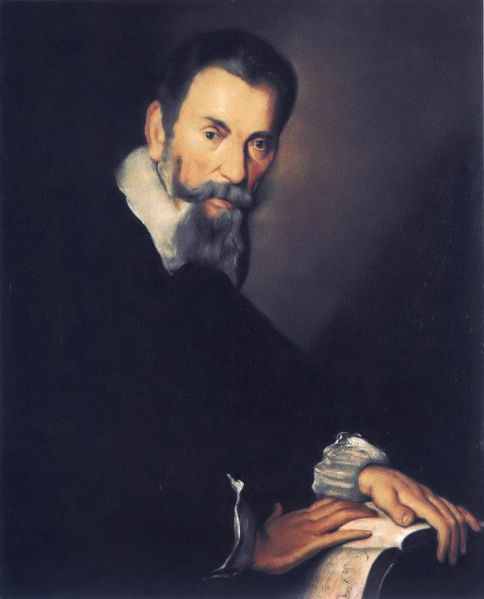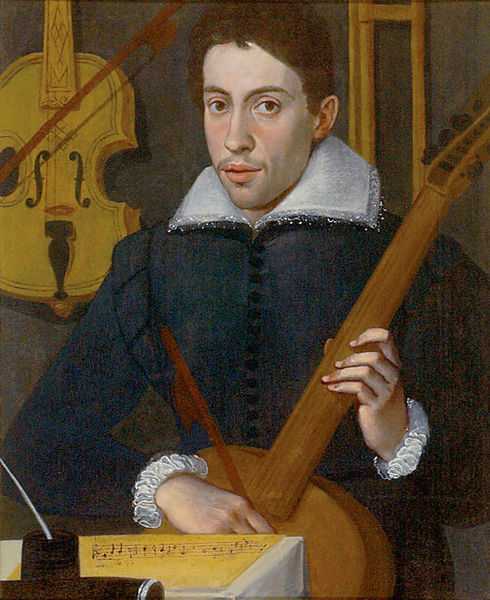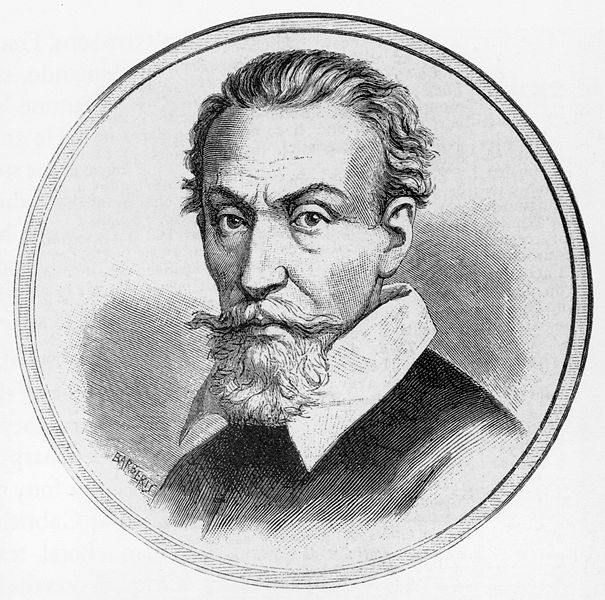<Back to Index>
- Composer, Gambist and Singer Claudio Giovanni Antonio Monteverdi, 1567
PAGE SPONSOR



Claudio Giovanni Antonio Monteverdi (15 May 1567 (baptized) – 29 November 1643) was an Italian composer, gambist and singer.
Monteverdi's work, often regarded as revolutionary, marked the
transition from the Renaissance style of music to that of the Baroque
period. He developed two individual styles of composition – the heritage
of Renaissance polyphony and the new basso continuo technique of the Baroque. Monteverdi wrote one of the earliest operas, L'Orfeo,
an innovative work that is still regularly performed. He was recognized
as an innovative composer and enjoyed considerable fame in his
lifetime.
Claudio Monteverdi was born in 1567 in Cremona, a town in Northern Italy. His father was Baldassare Monteverdi, a doctor, apothecary and surgeon. He was the oldest of five children. During his childhood, he was taught by Marc'Antonio Ingegneri, the maestro di cappella at the Cathedral of Cremona. The Maestro di capella’s job was to conduct important worship services in accordance with the liturgy books of the Catholic Church. Monteverdi learned about music by being part of the cathedral choir. He also studied at the University of Cremona. His first music was written for publication, including some motets and sacred madrigals, in 1582 and 1583. His first five publications were: Sacrae cantiunculae, 1582 (collection of miniature motets); Madrigali Spirituali, 1583 (a volume of which only the bass partbook is extant); Canzonette a tre voci, 1584 (a collection of three voice canzonettes); and the five part madrigals Book I, 1587, and Book II, 1590. Monteverdi worked for the court of Mantua first as a singer and violist, then as music director. He worked at the court of Vincenzo I of Gonzaga in Mantua as a vocalist and viol player. In 1602, he was working as the court conductor.
In 1599 Monteverdi married the court singer Claudia Cattaneo, who died in September 1607. He and his wife had two boys (Francesco and Massimilino) and one girl (Leonora) – another daughter died shortly after birth.
By 1613, he had moved to the San Marco in Venice where, as conductor, he quickly restored the musical standard of both the choir and the instrumentalists. The musical standard had declined due to the financial mismanagement of his predecessor, Giulio Cesare Martinengo. The managers of the basilica were relieved to have such a distinguished musician in charge, as the music had been declining since the death of Giovanni Croce in 1609.
In 1632, he became a priest. During the last years of his life, when he was often ill, he composed his two last masterpieces: Il ritorno d'Ulisse in patria (The Return of Ulysses, 1641), and the historic opera L'incoronazione di Poppea (The Coronation of Poppea, 1642), based on the life of the Roman emperor Nero. L'incoronazione especially is considered a culminating point of Monteverdi's work. It contains tragic, romantic, and comedic scenes (a new development in opera), a more realistic portrayal of the characters, and warmer melodies than previously heard. It requires a smaller orchestra, and has a less prominent role for the choir. For a long period of time, Monteverdi's operas were merely regarded as of a historical or musical interest. Since the 1960s, The Coronation of Poppea has re-entered the repertoire of major opera companies worldwide.
Monteverdi died in Venice on 29 November 1643 and was buried at the church of the Frari.
Monteverdi's works are split into three categories: madrigals, operas, and church music.
Until the age of forty, Monteverdi worked primarily on madrigals, composing a total of nine books. It took Monteverdi about four years to finish his first book of twenty - one madrigals for five voices. As a whole, the first eight books of madrigals show the enormous development from Renaissance polyphonic music to the monodic style typical of Baroque music.
The titles of his Madrigal books are:
- Book 1, 1587: Madrigali a cinque voci
- Book 2, 1590: Il secondo libro de madrigali a cinque voci
- Book 3, 1592: Il terzo libro de madrigali a cinque voci
- Book 4, 1603: Il quarto libro de madrigali a cinque voci
- Book 5, 1605: Il quinto libro de madrigali a cinque voci
- Book 6, 1614: Il sesto libro de madrigali a cinque voci
- Book 7, 1619: Concerto. Settimo libro di madrigali
- Book 8, 1638: Madrigali guerrieri, et amorosi con alcuni opuscoli in genere rappresentativo, che saranno per brevi episodi fra i canti senza gesto.
- Book 9, 1651: Madrigali e canzonette a due e tre voci
While in Venice, Monteverdi also finished his sixth (1614), seventh (1619) and eighth (1638) books of madrigals. The eighth is the largest, containing works written over a thirty year period. Originally the work was to be dedicated to Ferdinand II, but because of his ill health, his son was made king in December 1636. When the work was first published in 1638 Monteverdi rededicated it to the new King Ferdinand III. The eighth book includes the so-called Madrigali dei guerrieri et amorosi (Madrigals of War and Love).
The book is divided into sections of War and Love each containing madrigals, a piece in dramatic form (genere rappresentativo), and a ballet. In the Madrigals of War, Monteverdi has organized poetry that describes the pursuits of love through the allegory of war; the hunt for love, and the battle to find love. In the second half of the book, the Madrigals of Love, Monteverdi organized poetry that describes the unhappiness of being in love, unfaithfulness, and ungrateful lovers that feel no shame. In his previous madrigal collections, Monteverdi usually set poetry from one or two poets he was in contact with through the court where he was employed. The Book 8 Madrigals of War and Love represent an overview of the poets he has dealt with throughout his life; the classical poetry of Petrarch, poetry by his contemporaries (Tasso, Guarini, Marino, Rinuccini, Testi and Strozzi), or anonymous poets that Monteverdi found and adapted to his needs.
The ninth book of madrigals, published posthumously in 1651, contains lighter pieces such as canzonettas which were probably composed throughout Monteverdi's lifetime representing both styles.
Monteverdi composed at least eighteen operas, but only L'Orfeo, Il ritorno d'Ulisse in patria, L'incoronazione di Poppea, and the famous aria, Lamento, from his second opera L'Arianna have survived. From monody
(with melodic lines, intelligible text and placid accompanying music),
it was a logical step for Monteverdi to begin composing opera. In 1607,
the premiere of his first opera, L'Orfeo, took place in Mantua. L'Orfeo was not the first opera, but the first mature opera, or one that realized all of its potential.
It was normal at that time for composers to create works on demand for
special occasions, and this piece was part of the ducal celebrations of carnival. (Monteverdi was later to write for the first opera houses supported by ticket sales which opened in Venice). L'Orfeo has dramatic power and lively orchestration. L'Orfeo
is arguably the first example of a composer assigning specific
instruments to parts in operas. It is also one of the first large
compositions in which the exact instrumentation of the premiere has come
down to us.
The plot is described in vivid musical pictures and the melodies are
linear and clear. With this opera, Monteverdi created an entirely new
style of music, the dramma per la musica or musical drama.
L'Arianna was the second opera written by Claudio Monteverdi.
It is one of the most influential and famous specimens of early baroque
opera. It was first performed in Mantua in 1608.
Its subject matter was the ancient Greek legend of Ariadne and Theseus.
During the last years of his life, Monteverdi was often ill. During
this time, he composed his two last masterpieces: Il ritorno d'Ulisse in patria (The Return of Ulysses, 1640), and the historic opera, L'incoronazione di Poppea, (The Coronation of Poppea, 1642), based on an episode in the life of the Roman emperor Nero. The libretto for Il ritorno d'Ulisse was by Giacomo Badoarro and for L'incoronazione di Poppea by Giovanni Busenello.
Monteverdi's first church music publication was the archaic Mass In illo tempore to which the Vesper Psalms of 1610 were added. The Vesper Psalms of 1610 are also one of the best examples of early repetition and contrast, with many of the parts having a clear ritornello. The published work is on a very grand scale and there has been some controversy as to whether all the movements were intended to be performed in a single service. However, there are various indications of internal unity. In its scope, it foreshadows such summits of Baroque music as Handel's Messiah, and J.S. Bach's St Matthew Passion. Each part (there are twenty - five in total) is fully developed in both a musical and dramatic sense – the instrumental textures are used to precise dramatic and emotional effect, in a way that had not been seen before.
- Messa in illo tempore (1610)
- Mass of Thanksgiving (1631)
- Messa a 4 da cappella (1641) (also: Missa in F), part of Selva morale e spirituale
- Messa a 4 v. et salmi a 1–8 v. e parte da cappella & con le litanie della B.V. (Mass for four voices, and Psalms ...) (published posthumously, 1650)